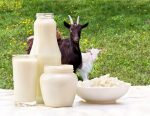As we all know, goats are very usable. They can be kept as a friendly company to your family and provide us their healthy milk, meat, also fiber, depending on what we need. While you can raise one breed for every purpose, actually each kind has its own specialty. Like Pygmy goats that are popular as pets, Saanen goats that are known for their milk, Boer goats for their meat production, and Cashmere goats that produce cashmere wool. Acknowledging what do you really want with your goats is one the basic thing to start your own goat farm.
Now, I assume that you’ve read the benefits of goat farm business before coming here, yes? If you are planning on raising goats for milk, well, you’ve come to the right place! Goats milk has smaller fat globules; easier to digest. In addition, fatty acids and high level of vitamin A inside of them is very good for our skin. Here we are going to talk about some recommended dairy goat breeds to your farm.
1. Saanen
Saanens are the most popular and often considered as the Holstein of dairy goats. They are the most productive milking goats in the world because Saanens produce up to 11.3 liters of milk per day. Their milk contains a minimum of 3.2% fat and 2.7% protein, which means lower butterfat than other breeds’ milk.
Well, seemed like our Saanens friend here have a lot of superlative adjectives; they are the largest breed of Swiss goat. For example, billies stand about 90 cm at the withers and weigh a minimum of 85 kg, so you might want to have large and strong shelter to withstand their big body.
They have white skin, a short white coat, and very mild-mannered. Being pale-skinned, they do not tolerate strong sun. Thus, they are usually raised intensively.
2. Nubian
Also known as Anglo-Nubian outside of North American. While they produce less milk than Saanens, their milk contains the highest butterfat contents of the standard dairy breeds at 4-5%. The number only surpassed by Nigerian Dwarf goats, Pygmy goats, and Boer goats which are rarely used for large scale milk production. Therefore, Nubian goats are recommended dairy goat breeds to your farm if you into cheese and soap making. They can produce milk with an average of 3.8 liters of milk a day. Though they are not the highest milk producer of the dairy goats, they can produce milk all year long.
Nubian goats are typically large in size and carry more flesh than other dairy breeds; does weighing at least 61 kg and 79 kg for bucks. The minimum height of the breed is 76 cm for does and 89 cm for bucks at the withers.
They have long, pendulous and floppy ear, also come in a wide variety of colors and patterns. Because of their ear, they have a variety of nicknames, including “Lop-eared Goat”, “Rabbit Goat”, and “Long-eared Goat”. What a cutie!
 3. LaMancha
3. LaMancha
They are medium sized and very hardy goats. Easily recognized by their lack of ear. Lack of ear? Not really, they just have very short pinnae that sometimes look like they have no ear at all. The exact opposite of Nubians, but that’s just the beauty of them, isn’t it?
LaMancha goats are known for their high milk production with comparatively high butterfat content. They produce an average of 3.7-5.5 liters of milk per day, with a butterfat content around 4%. They can thrive in any condition; harsh conditions leave little impact on their milk production. Making them a good addition to your farm.
Their temperaments are friendly, easy-going, and people-loving.
4. Alpine
Alpine goats originated in the French Alps, often also called French Alpine goats. Alpine goats are heavy milkers; they can produce up to 7.5 liters of milk per day with 3.5% butterfat. Compared to Saanen goats milk, Alpine goats milk is higher in all nutritional aspects, except the fat content, making it a much healthier choice. Their milk usually used to make thick substances made from milk, such as butter, cheese, soap, ice cream or any other dairy product normally made from cow’s milk.
They are medium to large size; mature billies are over 81 cm tall at the withers and does are over 76 cm tall at the withers. Their hair is short to medium in length and comes in all colors, also combinations of colors.
Alpine goats are friendly and highly curious. Even so, they can be very independent and strong-willed. They are described as being “alertly graceful” with the ability to adapt to any climate thanks to their hardy nature. But if you want to raise Alpine goats as dairy goat breed, they must be housed in specific conditions so that their milk production is not alarmed by changes. Changes in external factors lead to a decrease in milk production because of the pressure applied to them to adapt to these changes.
5. Nigerian Dwarf
They are small breed West African ancestry, making popular as pets due to their easy maintenance and small stature; does around 43–53 cm and bucks around 48–58 cm in height. About half the size of average goats. They come in many colors and patterns.
Despite their small size, Nigerian Dwarf goats produce within1-2 quarts of milk per day. A quite surprising quantity of milk for their size. Nigerian Dwarf goats milk contain 6-10% butterfat, one of the highest in dairy goat breeds. That means their milk is very creamy, also makes delicious cheese, ice cream, and yogurt.
Besides their size, their gentleness and intelligence making them great goats for kids and popular as pets. Considering their size, you might be able to keep them at the backyard. Thus, Nigerian Dwarf goats are recommended dairy goat breeds for your farm if you want to produce your own milk at home.

